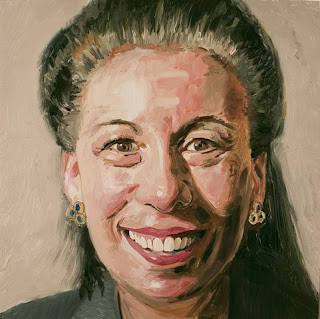 |
| Portrait of Barbara Sexton-Smith, painted by local artist Shayne Hull. |
Almost a year after controversy that resulted in the departure of long-time Fund for the Arts president and CEO Allan Cowen, Interim President and CEO Barbara Sexton-Smith participated in a public forum at the Louisville Visual Art Association at the Louisville Water Tower on January 12. This fairly unprecedented event was a unique opportunity for those who have been most critical of the Fund’s operations to put their questions and concerns directly to the leadership. It was attended by a cross-section of artists representing visual and performing arts in Louisville and Southern Indiana. We have observations from two of our contributors who also attended:
Kathi E.B. Ellis
This portion is copyright © 2012 Kathi E.B. Ellis. All rights reserved.
Visual artists have been among the most vocal calling for changes to The Fund’s way of operating following the abrupt resignation of former president and CEO Allan Cowen last year. This forum was framed around an open letter signed by more than thirty visual artists, gallery owners and other arts activists. Ms. Sexton-Smith, as she has at the many public gatherings which she’s addressed in recent months, embraced the opportunity to tell the Fund’s story and identify specific strategies she’s implemented to shift the community’s perception about how the Fund operates. Ms. Sexton-Smith is an energetic and compelling speaker who relishes telling stories that make her points for her. A signature moment of her leadership style occurred when she was asked by WFPL’s Gabe Bullard how the Fund handled last year’s controversy. What was critical, she said, was to “protect the legacy” of the Fund; she and the team stayed out in the community, ready to talk to anyone who had questions.
Issues that were addressed during the forum included transparency (all the financial information is on the website; partner organization board presidents are ex-officio Fund board members); term limits for board members (these have been introduced); diversity on the board (the NeXt! Leadership program is a vehicle to address this long term); size of the board (when raising the dollar amounts of Fund campaigns, a broad representation of the community is necessary to keep the organization viable: $5 million of the $7 million raised in 2011 came through connections from board member’s organizations); simplifying the application for funding process (a review is in process with changes already being implemented); opening up the funding process to more organizations; and the contrast in funding levels for performing and visual arts (visual arts account for 2.56% of the allocation budget).
Mary Margaret Sparks:
This portion is copyright © 2012 Mary Margaret Sparks. All rights reserved.
The first big discussion point focused on the FFTA allocations to organizations, long a subject of frustration for local artists working both in and outside of Fund member groups. In the spring of 2011, Sexton-Smith began the process of reviewing the budget process and researching how other united arts funds allocate their money. An allocations team was created of members outside of the FFTA but from their cultural partners: i.e., arts organization employees and arts organization board members. A process of budget review and changes could take anywhere from 2 to 5 years, so Sexton-Smith created three new programs to bring about immediate change and help provide additional funding to organizations.
· Power2give – Any non-profit can submit projects ranging from new photography equipment for photographing artwork to costumes and sets for theatre productions. The FFTA matches every dollar raised. http://www.power2give.org
· Innovation Fund – $200,000 to help fund innovative projects from non-profit organizations in the region.
· Employee Campaign Strategy – If a cultural partner brings a campaign to the FFTA, that cultural partner will receive 75% of the money that comes in as a result of that campaign.
The FFTA board of directors served as a platform for some surprisingly candid and forthright analysis from Sexton-Smith, who acknowledged the lack of racial, gender, economic and geographic diversity among its members. Since she assumed the Interim position, five members whose three-year terms were about to expire have rotated off and been replaced by new members of both race and gender. Sexton-Smith also hopes to create a term limit for board members and to reduce the size of the board. She also plans to add more creative representation including artists, curators and art collectors.
Other issues brought up for discussion included:
How can the FFTA play a bigger role in arts advocacy for Louisville and the state? The FFTA will be attending Arts Day in Frankfort on February 2. They will partner with LexArts from Central Kentucky on art advocacy issues.
How can smaller non-profits become a cultural partner? Non-profits interested in becoming cultural partners should just contact the FFTA directly.
Will money raised in certain regions go back to support programs in those regions; i.e., southern Indiana? The FFTA is incorporating donor advised funding in place of general “direct mail” donations. Investors who give money to the FFTA can designate where that money goes. Currently, the FFTA ensures that products and programs from their cultural partners are fairly distributed in all areas where they receive donations.
Will heritage, history and humanity organizations be able to receive funding from the FFTA? Programs such as the innovation fund and power2give allow those organizations to apply for funding through the FFTA.


![Theatre [502] In Transition](https://arts-louisville.com/wp-content/uploads/2019/10/72854126_10157359799716839_7211972597972467712_o-440x264.jpg)

